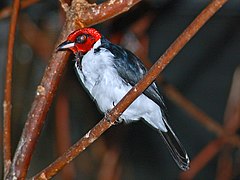Red-capped cardinal
| Red-capped cardinal | |
|---|---|
 |
|
| Paroaria gularis at Bird Kingdom, Niagara Falls | |
| Scientific classification | |
| Kingdom: | Animalia |
| Phylum: | Chordata |
| Class: | Aves |
| Order: | Passeriformes |
| Family: | Thraupidae (and see text) |
| Genus: | Paroaria |
| Species: | P. gularis |
| Binomial name | |
|
Paroaria gularis (Linnaeus, 1766) |
|
The red-capped cardinal (Paroaria gularis) is a small South American bird. It belongs to Paroaria, a genus of red-headed cardinal-tanagers.
The genus Paroaria is classified in the family Thraupidae, unlike the cardinals proper which are in the Cardinalidae. They were long believed to be closer to American sparrows and placed in the Emberizidae.
The masked cardinal was formerly considered conspecific with the red-capped cardinal. The masked cardinal markedly differs from the red-capped cardinal by the black ear-coverts and the red (not black) lower throat and upper chest. Additionally, its lower mandible is typically whitish, but this is not entirely consistent, as it occasionally is pale flesh-coloured. This distinctive taxon was determined a different species, as suggested by the lack of hybridization with P. g. gularis in the limited area of overlap in southern Venezuela.
The adult red-capped cardinal is 16.5 cm (6.5 in) long and weighs about 22 g. (0.78 oz). The nominate subspecies has a crimson head, blackish lores and ocular region, and shiny black upperparts, apart from a white partial collar extending up the neck sides from the white underparts. The throat is black, extending to a point on the upper chest. The upper mandible is black, while the lower is pale flesh-coloured. The legs are dark grey (almost black) and the iris is brownish-orange. In pattern the juvenile resemble the adults, but the upperparts are dusky-brown, the head is deep brownish-buff (darker on the cap), the bill is entirely black and the iris is pale, dull creamy-yellow.
The song is a variable, often repeated series of suweet-chu notes, and the call is a sharp chep.
It occurs in lowlands of the Guianas, Venezuela, eastern Colombia, eastern Ecuador, eastern Peru, northern and eastern Bolivia and the Amazon basin in Brazil. In Brazil it is, except for populations in the relatively open lowlands of north-eastern Roraima and along the Branco River and lower Rio Negro, apparently largely absent from the regions north of the northern bank of the Amazon River, but these regions are generally very poorly known and its presence cannot be discounted, especially in the section between the lower Rio Negro and Rio Jari (the river on the border between Pará and Amapá).
...
Wikipedia

